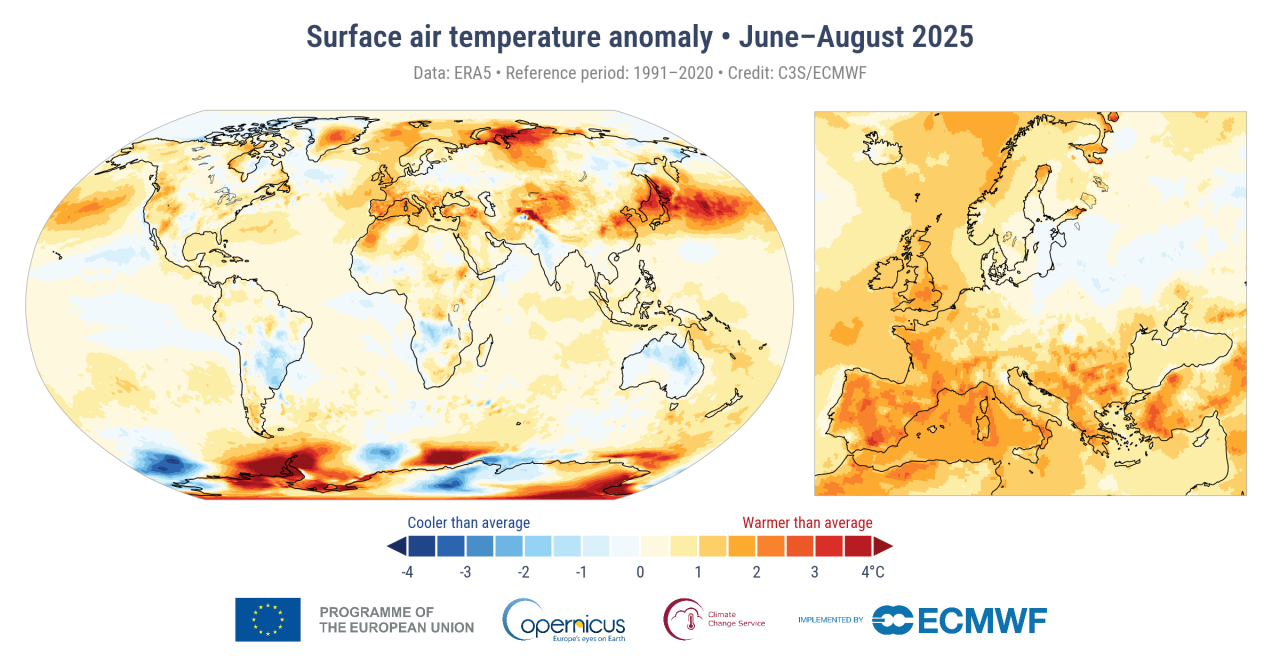From plankton to seabirds, it’s bad news for foodwebs in the Pacific and coastal environments: there are some hints that the Blob may be back for another round.
Clues about the possible reemergence of the Blob – a recurring Pacific marine heatwave – can be seen in this summer’s global ocean data.
In August 2025, the average sea surface temperature between 60 degrees south and 60 degrees north latitude reached 20.82°C (69.47°F), the third-highest for the month since records began, according to the EU’s Copernicus Climate Change Service. That figure was only 0.16°C (0.288°F) below the August 2023 record.
Most of the North Pacific stood out as a hotspot with vast stretches of ocean running far warmer than average and some areas breaking all-time records. According to some media reports, this could be an indication that the Blob’s reign of terror is continuing. And this time, it may be even more extensive than before, covering an estimated 8,000 kilometers (5,000 miles) from the tip of Alaska all the way to Japan, CNN reports.
The Blob is a swarming mass of warm water in the North Pacific Ocean. Acting as a marine heatwave, temperatures within this patch of sea can cook up to 2.5°C (4.5 °F) to 5.5°C (10°F) warmer than typical of any given time of the year.

Surface air temperature anomaly for the boreal summer from June to August 2025 relative to the average for 1991-2020: note the red patch over the North Pacific.
Image Credit: Copernicus Climate Change Service/ECMWF.
“The Blob is caused by a combination of warmer air temperatures (that warms the ocean’s surface), changes in the patterns of wind speed, direction and duration (wind helps mix the ocean and by bringing cool water from depth) and the persistent mass of warmer water along the equator known as ENSO [El Niño-Southern Oscillation],” writes the National Park Service.
“This very warm mass of water is unusual, an anomaly. In fact, nothing like it has been seen in the climate record since climatologists have been recording data in this region.”
It was first recorded in late 2013 when it stretched over 1,600 kilometers (1,000 miles) in the North Pacific and was up to almost 100 meters (over 300 feet) deep. Between 2013 and 2018, the Blob broke apart into three separate masses: one in the Bering Sea, another off the California–Mexico coast, and a third along the coasts of Canada, Washington, and Oregon.
In 2019, another surge in Pacific Ocean temperatures was recorded, prompting some to dub it “The Blob 2.0”.
This year, the strange marine heatwave appears to be further across the North Pacific, spanning from Alaska’s Aleutian Islands to the coast of East Asia.
If the Blob has truly returned, it’s bad news for ocean life. Cold, nutrient-rich water boosts the growth of plankton, the microorganisms that act as a base of the marine food web. When warm waters suppress nutrients and oxygen, the chain collapses: fewer plankton mean fewer small fish, which means hungry seabirds, marine mammals, and other predators up the line.
The consequences can be catastrophic. A study found that up to 4 million seabirds, especially common murres, were killed during the 2014 and 2016 Blob event, making it the worst single species die-off in modern history. Over 62,000 carcasses washed up on the shores of Alaska by the end of 2016, and, with no signs of recovery, the researchers believe it triggered an irreversible ecosystem shift.
As for 2025, it isn’t yet clear what the longer-term impacts might be on weather patterns in the Pacific region. However, if previous years are anything to go by, it could ripple far beyond the immediate food web, influencing Pacific weather patterns and global climate systems further afield.
Source Link: Return Of The Blob? Unusual Conditions In North Pacific Ocean Now Stretch From US Coast To Japan